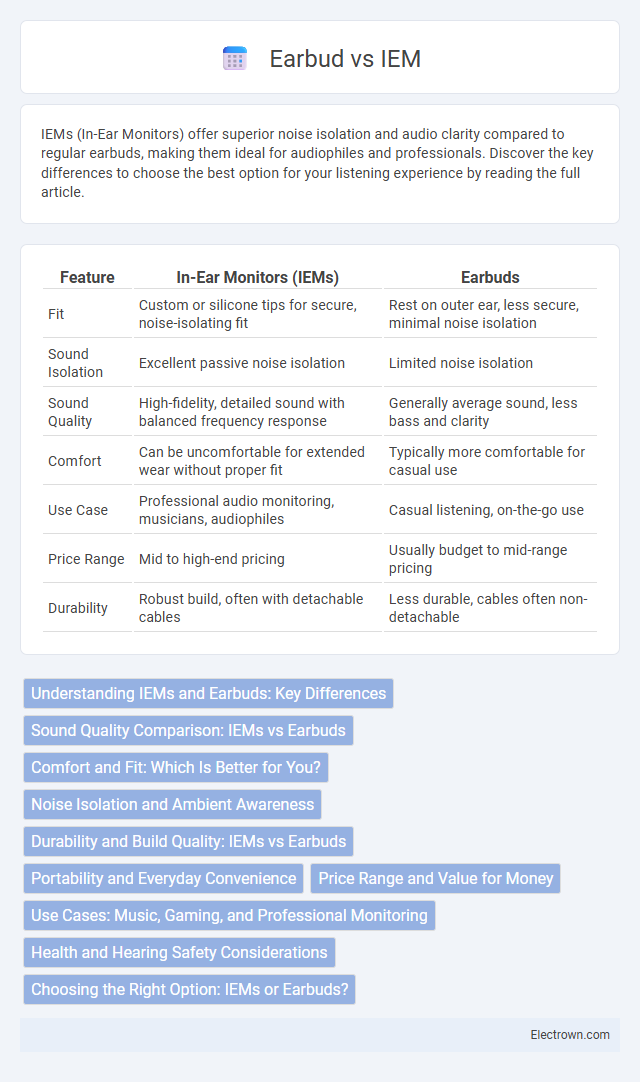IEMs (In-Ear Monitors) offer superior noise isolation and audio clarity compared to regular earbuds, making them ideal for audiophiles and professionals. Discover the key differences to choose the best option for your listening experience by reading the full article.
Table of Comparison
| Feature | In-Ear Monitors (IEMs) | Earbuds |
|---|---|---|
| Fit | Custom or silicone tips for secure, noise-isolating fit | Rest on outer ear, less secure, minimal noise isolation |
| Sound Isolation | Excellent passive noise isolation | Limited noise isolation |
| Sound Quality | High-fidelity, detailed sound with balanced frequency response | Generally average sound, less bass and clarity |
| Comfort | Can be uncomfortable for extended wear without proper fit | Typically more comfortable for casual use |
| Use Case | Professional audio monitoring, musicians, audiophiles | Casual listening, on-the-go use |
| Price Range | Mid to high-end pricing | Usually budget to mid-range pricing |
| Durability | Robust build, often with detachable cables | Less durable, cables often non-detachable |
Understanding IEMs and Earbuds: Key Differences
In-ear monitors (IEMs) provide superior sound isolation and detailed audio fidelity by sealing the ear canal with customizable tips, whereas earbuds rest outside the ear canal and often allow more ambient noise. IEMs are preferred by audiophiles and professionals for their high-quality sound and noise isolation, while earbuds offer comfort and convenience for casual listening. Your choice depends on whether you prioritize immersive audio experience or ease of use and portability.
Sound Quality Comparison: IEMs vs Earbuds
In-ear monitors (IEMs) deliver superior sound quality compared to earbuds due to their custom-fit design that provides better noise isolation and enhanced bass response. IEMs use multiple balanced armature or dynamic drivers to produce clearer mids and highs, whereas earbuds typically rely on a single driver, resulting in less detailed audio. The sealed fit of IEMs reduces external noise interference, allowing for a more immersive and accurate listening experience.
Comfort and Fit: Which Is Better for You?
In-ear monitors (IEMs) provide a customizable fit with interchangeable ear tips, offering superior noise isolation and comfort tailored to individual ear shapes, making them ideal for extended use. Earbuds rest on the outer ear without penetrating the ear canal deeply, which can be less intrusive but might cause discomfort during prolonged wear and offer less sound isolation. Choosing between IEMs and earbuds depends on personal ear anatomy and preference for isolation versus a looser fit, with IEMs generally favored for comfort during long listening sessions.
Noise Isolation and Ambient Awareness
In-ear monitors (IEMs) provide superior noise isolation by creating a tight seal within the ear canal, effectively blocking out ambient noise for a more immersive listening experience. Earbuds rest on the outer ear and allow more external sounds to filter in, offering greater ambient awareness useful for situational awareness during activities like commuting or walking. Your choice depends on whether you prioritize isolation to focus on music or ambient awareness for safety and situational sensitivity.
Durability and Build Quality: IEMs vs Earbuds
In-ear monitors (IEMs) typically feature robust construction with high-quality materials like metal or reinforced plastics, enhancing durability compared to standard earbuds that often use lighter, less resilient plastics. The snug fit and replaceable cables of many IEMs contribute to longer lifespan and resistance to wear and tear, while earbuds usually have fixed cables prone to tangling and damage. Investing in IEMs can provide your audio gear with superior build quality, ensuring consistent performance over time.
Portability and Everyday Convenience
IEMs (In-Ear Monitors) offer superior portability due to their compact, lightweight design, making them easy to carry and ideal for daily commuting or workouts. Earbuds typically provide a more comfortable fit for casual use, but often sacrifice secure placement and noise isolation, influencing everyday convenience. Both devices enhance mobility, yet IEMs excel in delivering a stable, immersive listening experience without bulk.
Price Range and Value for Money
In-ear monitors (IEMs) typically range from $50 to over $1,000, offering superior sound isolation and audio clarity that justify their higher price for audiophiles and professionals. Earbuds generally cost between $10 and $200, providing more affordability but often compromising on sound quality and noise isolation. Your choice depends on whether you prioritize budget-friendly convenience or investing in higher-value, professional-grade audio performance.
Use Cases: Music, Gaming, and Professional Monitoring
IEMs (In-Ear Monitors) offer superior noise isolation and precise audio reproduction, making them ideal for professional monitoring and critical listening in music production. Earbuds provide comfortable, casual listening and are often preferred for gaming due to their less intrusive design and compatibility with various devices. For music enthusiasts seeking detailed sound and gamers prioritizing comfort during long sessions, the choice depends on whether isolation or ease of use is the primary concern.
Health and Hearing Safety Considerations
IEMs (In-Ear Monitors) provide better noise isolation, reducing the need to increase volume and lowering the risk of hearing damage compared to standard earbuds. Properly fitted IEMs minimize external sound interference, allowing users to listen at safer decibel levels, thereby protecting long-term auditory health. However, prolonged use of both IEMs and earbuds at high volumes can lead to hearing impairment, emphasizing the importance of volume moderation and regular hearing breaks.
Choosing the Right Option: IEMs or Earbuds?
In-ear monitors (IEMs) offer superior sound isolation and detailed audio quality, making them ideal for professional use and critical listening. Earbuds provide a more comfortable, open design that allows ambient sound awareness, suitable for casual, everyday use. Selecting between IEMs and earbuds depends on your priorities for sound fidelity, noise isolation, and comfort during extended wear.
iem vs earbud Infographic

 electrown.com
electrown.com